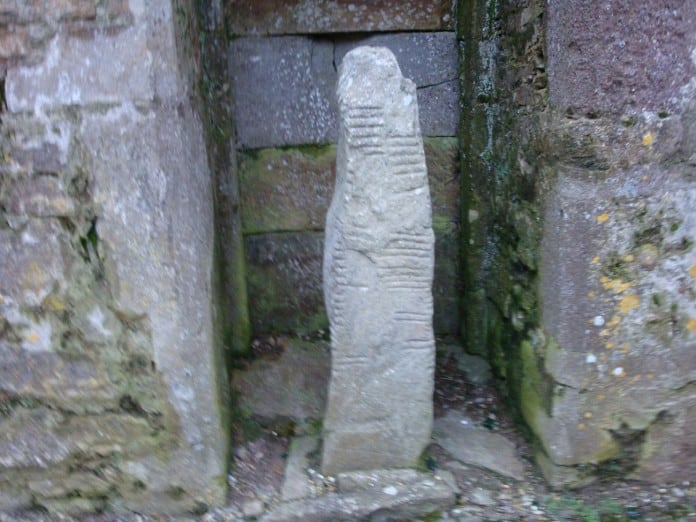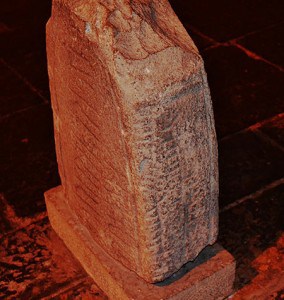
Celtic Ogham Stones are dotted across Ireland, they provide more of an insight in to our past as they bear the marks of ancient communication – Ogham Script.
These are Irelands version of a stone monument phenomena that can be observed across the whole of the Earth’s ancient cultures.
Some such as Stonehenge are well known and yet in reality we know very little for certain who put them there, what they represent or even how they were built.
Others, such as the Celtic Ogham Stones, contain an alphabet that we can decipher and learn something about our ancestors from.
Manuscripts on Celtic Ogham Stones
Ogham Stones (pronounced Oh-am) are found predominantly across Ireland, but can also be seen in Wales, Scotland, England and the Isle of Man.
The Celtic Ogham alphabet is believed to date back to the period of the pre-Christian, Roman invasion in the UK, between circa. 50BC and the fifth century AD.
We know a fair amount relating to the Roman invaders and settlers for this period, yet we know relatively little of the Celtic people.
The symbols could easily have remained a mystery, but fortunately for modern scholars, the Medieval-era manuscripts listed below include copies of treatises dealing with Ogham.
- Leabhar Bhaile an Mhóta (the Book of Ballymote).
- Leabhar Buidhe Leacáin (the Yellow Book of Lecan).
- Lebor Laignech (the Book of Leinster).
- In Lebor Ogaim (the Ogham Tract).
- Auraicept na n-Éces (the Scholar’s Primer).
It is upon these manuscripts, which originally date from the seventh century, that our modern understanding of Ogham script is based.
Despite these sources, the origins and indeed purpose of the alphabet are still unclear.
Contemporary scholars are broadly divided into two camps in terms of origin or purpose:
- those who believe it was used as a ‘secret’ language during the Roman invasion and rule, such as modern scholars James Carney and Eoin MacNeill;
- those, including modern scholar Damian McManus, who believe that the alphabet originated with early Christian converts.
It is generally accepted that it has a Latin or Greek origin and that it was used to communicate and record information in Primitive and Old Irish, as well as Pictish, Old Welsh and probably Latin.
Despite the mystery surrounding the alphabet, translations of the Ogham script seem to reveal prosaic information. Primarily people’s names, suggesting that the stones were possibly graves, or records of land ownership or population.
A Legendary Account
Both the ancient and medieval texts interpret the letter names as trees or plants. Although these records are unclear and even contradictory on the etymology, or roots, of these words.
Add to the mix the changes to languages in the last two millennia, plus the influences of Latin, Primitive Irish, Old Irish, runes, modern Irish and even the English translations and understandably there is a huge depth of possible interpretation.
Some academics propose that the alphabet is known as a Tree Alphabet because the strokes are akin to branches, rather than because they each represent a tree.
However, the link to nature leads to a third, less widely-held and rather more mysterious theory.
Some believe that the Ogham alphabet was developed by Druids, possibly based on runes.
Proponents of this, including 20th century archaeologist RAS Macalister, point to the idea that each of the symbols represents one of the UK’s trees or shrubs.
There is little factual evidence to back this up, although it does make for a delightfully mythical and mysterious story which has captured the attention of modern-day pagans and New Agers.
Ireland’s rich folkloric history has its own theories as to who created the alphabet.
According to some records, including the Lebor Gabála Érenn and the Auraicept na n-Éces, it was invented after the fall of the Tower of Babel by the Scythian king Fenius Farsa as a way of writing down his language in Bérla tóbaide, or ‘the selected language’.
Other literature, including The Ogam Tract, tells of the alphabet being created by Ogma mac Elathan as a means by which the educated and wise could communicate with each other.
It also gives a variety of some 100 “scales” of variant or secret modes of writing Ogham script.
One of them, known as Aradach Fionn or ‘Fionn’s Ladder’, has given rise to the theory that Ogham is a form of recording musical notation.
Although unproven it is thought to be a of tablature to guide the musicians fingering expression through the strings of the Celtic harp.
Ogham Alphabet
So, what is the Ogham Alphabet?
It’s made up of 25 symbols, or letters, which are represented as a series of lines, or strokes, linked by a solid line.
They look a little like a tally chart. Vowels are written as dots on a line, rather like beads on a stick.
The letters are grouped in to five aicmí (plural), or classes. The fifth aicme (singular), forfeda, was thought to have been added when it became used in manuscripts.
On carvings the letters are written vertically and read bottom to top, left to right but in manuscripts (which date from the 6th Century onwards) the alphabet is written horizontally, again left to right.
The first four aicmí are named after the first letter in their group, B, H, M and A
1st – aicme b (beith or birch) contains the letters b, l, f, s and n
2nd – aicme h (uath or hawthorn), contains h, d, t, c and q
3rd – aicme m (muin or vine) – m, g, ng, z and r
4th- aicme a (ailm or white fir) – a, o, u, e, and i
The fifth aicme contains the sounds ea, oi, ui, ia and ae.
There are also symbols for marking the beginning and end of texts, and for inserting spaces.

Ogham script was probably written on wood as well as stone, but wooden examples haven’t stood the test of time.
Where to See Celtic Ogham Stones
There are nearly 400 verified examples of stones with Ogham script engraved on them, with the majority in the Republic of Ireland, some in situ in the countryside and others in museums or churches.
Ogham stones can be found in Saint Flannan’s Cathedral, Killaloe, County Clare; Ballycorvane Bay, County Cork; and Saint Declan’s Cathedral, Ardmore, County Waterford. There are also examples in the National Museum in Dublin.
Further afield, there are stones in Pembrokeshire, Wales; Cornwall and even one in Silchester, Berkshire, which was the site of a large Roman settlement.
In addition to the Celtic Ogham stones, examples of manuscripts that are written Ogham script sources still remain.
The Royal Irish Academy in Dublin houses the 14th century Book of Ballymote.
Fragments of the Lebor Ogaim are kept at Trinity College Dublin, the Royal Irish Academy, the National Library of Ireland and the British Library.
The 12th-century Book of Leinster is also kept at Trinity College Dublin.

